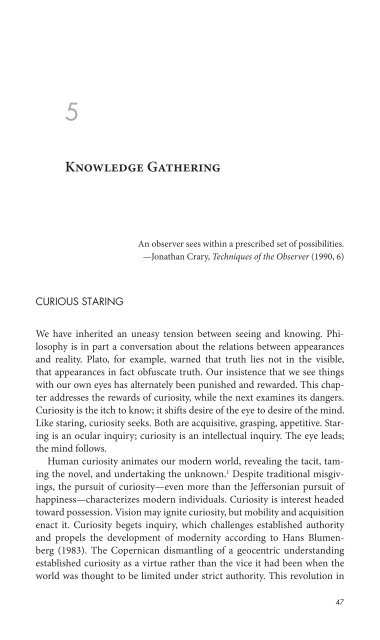Staring how we look sobre la mirada.pdf - artecolonial
Staring how we look sobre la mirada.pdf - artecolonial
Staring how we look sobre la mirada.pdf - artecolonial
Create successful ePaper yourself
Turn your PDF publications into a flip-book with our unique Google optimized e-Paper software.
A PHYSICAL RESPONSE 19<br />
in search of information. Drawn by the inexplicable, <strong>we</strong> try to integrate new<br />
information into what <strong>we</strong> already know to reduce our uncertainty about the<br />
world. Both Berns and Langer assert that what humans really want is predictability<br />
in what <strong>we</strong> grudgingly know to be an unpredictable world. 4 Ironically,<br />
at the root of our craving for novelty is an anxious drive to be rid of it<br />
so that <strong>we</strong> can sink into a calmer world where nothing startles or demands<br />
our visual attention.<br />
Here is the contradiction at the heart of staring, then: the extraordinary<br />
excites but a<strong>la</strong>rms us; the ordinary assures but bores us. We want surprise,<br />
but perhaps even more <strong>we</strong> want to tame that pleasurable astonishment, to<br />
domesticate the strange sight into something so common as to be unnoticeable.<br />
These c<strong>la</strong>shing impulses make staring self-cancelling, abating once <strong>we</strong><br />
reassert the equilibrium of familiarity. Langer says that <strong>we</strong> judiciously court<br />
the novel, trying to control our visual explorations. In other words, <strong>we</strong> prefer<br />
to stare for our own reasons and on our own terms rather than be forced into<br />
a stare by something or someone stareable. For example, the middle-c<strong>la</strong>ss<br />
value of traveling, seeking a diverse environment, or even favoring ethnic<br />
food can be seen as forms of deliberate, and therefore controlled, stimu<strong>la</strong>tion<br />
through novelty, positioned within a model of consumption that indicates<br />
upper-c<strong>la</strong>ss status. Such intentional novelty seeking differs from a<br />
reactive stare driven by the novel object. The ra<strong>we</strong>st, most basic form of<br />
staring is the physiological expression of being caught off guard, captured by<br />
the unexpected. <strong>Staring</strong> is at once a pleasurable encounter with novel stimuli<br />
and a disconcerting hijacking of our visual agency by the impulse to stare.<br />
We at once want and do not want to gawk at such compelling sights.<br />
Because <strong>we</strong> both crave and dread unpredictable sights, staring encounters<br />
are fraught with anxious contradiction. The functional and formal conditions<br />
of our bodies that are termed disabilities are one of the most unpredictable<br />
aspects of life. Like death itself, disabilities come to us unbidden as <strong>we</strong> move<br />
through a world that <strong>we</strong>ars us down even while it sustains us. Seeing disability<br />
reminds us of what Bryan S. Turner (2006) calls “ontological contingency,”<br />
the truth of our body’s vulnerability to the randomness of fate. Each one of<br />
us ineluctably acquires one or more disabilities—naming them variably as<br />
illness, disease, injury, old age, failure, dysfunction, or dependence. This inconvenient<br />
truth nudges most of us who think of ourselves as able-bodied toward<br />
imagining disability as an uncommon visitation that mostly happens to<br />
someone else, as a fate some<strong>how</strong> elective rather than inevitable. In response,<br />
<strong>we</strong> have refused to see disability. Avowing disability as tragic or shameful,<br />
<strong>we</strong> have hidden away disabled people in asylums, segregated schools, hospitals,<br />
and nursing homes. 5 When <strong>we</strong> ourselves develop disabilities, <strong>we</strong> often<br />
hide them as <strong>we</strong>ll, sometimes through semantic slights-of-hand, sometimes<br />
through normalizing medical procedures that erase disability, and sometimes


